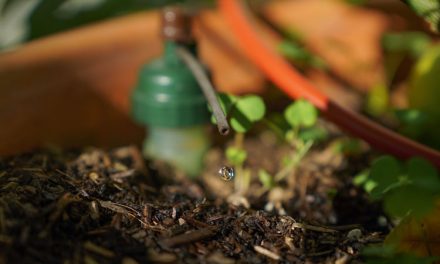Posted March 24th, 2017 by Jack Bohannan in the May-June 2017 edition of Professional Marijuana Grower

All growers have done it: damaged a plant with erratic watering practices. But for cannabis cultivators, the compromised health of just one or two prized plants can significantly impact the bottom line. Experienced growers rarely let dehydration occur, and larger greenhouse grows incorporate systems that all but guarantee underwatering doesn’t happen. Yet the painful memories and guilt of underwatering persist in the minds of even the best cultivators and sometimes lead to the less recognizable sin of continual, low-level overwatering.
Severe overwatering causes necrosis and root rot; moderate overwatering causes obvious leaf droop; mild overwatering can be hard to detect, yet it slows the growth of cannabis at all stages of the lifecycle. The subterranean half of the plant can be more difficult to assess than the foliage, so issues that aren’t causing outright problems are likely to go unnoticed.
Ironically, idyllic greenhouse environments prompt overwatering concerns for the very reason of their near-perfection. Why? Greenhouses create high-humidity environments that are ideal for keeping stomata open for CO2 intake (and thus maximized photosynthesis), but in ever-present humidity plants don’t have an opportunity to release extra moisture. In nature, photosynthesis usually occurs during a short period in the morning when humidity is higher. At that time, stomata can open to take in CO2 without much moisture loss, and plants have opportunity to transpire excess soil moisture later in the day when the temperature is higher. Because greenhouses constantly provide this high-humidity/open-stomata state, plants don’t have a chance to release surplus water should overwatering occur.
How plants metabolize water, or fail to metabolize water, is best conceptualized as two processes: one occurring in the canopy and the other at the roots. The need for moisture primarily originates with the need to cool the foliage, so it makes sense to examine the canopy environment first.
Moisture Processes in the Canopy
Vascular plants like cannabis have one primary mechanism for responding to environmental stimuli like excess heat, humidity or soil moisture: they open and close their stomata. Opening and closing the stomata controls many processes, like the intake of CO2, but it also allows them to release moisture, thus regulating their leaf temperature through evapotranspiration and manipulating nutrient intake by controlling the pull of water up the stems and into the leaves.
Growers measure environmental moisture as relative humidity (RH), that is, the quantity of water molecules that the air can carry relative to its temperature. A given quantity of water and air molecules creates pressure on the leaves, and air temperature factors into the equation to determine the total effective pressure. Yet the pressure that isn’t there, otherwise known as the vapor pressure deficit, is more important in the “minds” of the plants. Because the outside air pressure is less than the complete saturation of the leaves, a relative vacuum acts on the leaf surface, and a ‘pull’ is created through the stomata. This ‘pull’ at the leaves draws water up from the soil and affects how much watering is appropriate.
In actuality, relative humidity is a limited metric for manipulating the photosynthesis of plants. Temperature is the contingent variable that makes humidity relevant to proper transpiration because it determines the pressure deficit. Ambient air at 80°F/70% RH contains more vapor and exerts more pressure (has a lower vapor pressure deficit) than air at 70°F/70% RH (higher vapor pressure deficit). Even within cannabis’ preferred ranges of temperature and RH, vapor pressure deficit can vary significantly if the two variables are mismatched (e.g. temperature is at the low end of the range while RH is high).
An unsuitable vapor pressure deficit affects the ability of stomata to diffuse moisture, and that affects the plant’s soil moisture preferences. With too little pressure (hot or dry conditions), a relative vacuum causes rapid moisture loss. The plants then close their stomata to slow the loss of moisture, curl their leaves to limit exposure to sunlight, and their photosynthesis slows. With too much pressure (cool or moist conditions), the stomata cannot release moisture and important minerals like calcium cannot be transported up into the plants’ leaves.
The upshot of all this is that with the introduction of excess moisture at the roots, the perfect environmental conditions (temperature, humidity and even CO2 levels) are suddenly much less perfect and even mildly objectionable to the plant. In other words, environmental conditions dictate the appropriate moisture level of the soil and necessitate measurement-based watering in order to remain ideally matched. Avoiding excess watering has the added benefit of avoiding the increased humidity responsible for 25% of cooling costs too.
Moisture Processes at the Roots
Similar to the vapor pressure gradient at the canopy, a plant/moisture relationship influences water and nutrient uptake at the roots. Hydrostatic pressure, the natural result of water in the soil, must be sufficient to help drive moisture and nutrients up the xylem of the stems into the leaves where photosynthesis occurs. Negative hydrostatic pressure (more pressure in the roots than in the soil) can effectively pull water out of the plant. Excessive hydrostatic pressure occurs in instances of overwatering when the plant cannot absorb the water and the soil cannot drain.
Most greenhouse systems depend on irrigation timers to control hydrostatic pressure (i.e. watering), but some passive devices, like the Troph Blumat (BlumatSystems.com), use the principle of negative hydrostatic pressure to let the plant determine when it needs water on its own. This simple approach effectively allows the plant match its moisture intake with the environmental factors of the moment. The Blumat is a ceramic, water-filled cone that is inserted into the soil, creating its own pressure gradient relative to the soil moisture. When negative hydrostatic pressure increases in the soil, it increases in the Blumat as well. This suction pulls open a valve to an irrigation line, which emits water until the pressure gradient is restored. The plants effectively control their own watering schedule, tailoring it in response to the current environmental conditions of the grow room. Irrigation processes similar to this approach help increase water-use efficiency by eliminating runoff, and in doing so, mitigate excess humidity, and nutrient waste.
In general soil assessments, optimum hydrostatic pressure is thought to occur when the air pockets within the soil are 50% saturated with water. Many cannabis cultivators prefer moisture pressures of 120–150 mbar in the vegetative stage and 150–180 mbar in flower depending on the strain. When water levels exceed this amount and approach saturation, the plant cannot respirate and begins to “drown” because the oxygen needed at the roots is displaced by H2O. “Drowning” is an often-used and apt descriptor! While the canopy requires CO2, the roots need oxygen to accept the stray electrons resulting from the ionic processes of sugar synthesis. If they cannot access enough oxygen to respirate, the photosynthetic process is slowed and the roots begin to die.
In addition to the roots’ immediate need for oxygen, improper watering can damage beneficial soil microbes. The majority of nitrogen used by the plants comes from bacteria, protozoa, and microscopic nematodes, so their health directly impacts that of the plants. Adequate moisture is necessary for microbes to take in nutrients, digest them and expel waste. Insufficient water pockets also limit these creatures’ mobility and, for protozoa, their ability to reproduce. The impact on component species of the soil ecosystem becomes cumulative, and the soil loses the ability to support the plant. Additionally, when too much moisture is introduced and the air is displaced, the ecosystem becomes an anaerobic environment. Of the myriad species of microbes existing in the root system, some can indeed thrive in anaerobic conditions, but they often create undesirable alcohol and other metabolic byproducts that kill roots. This is why soil that has been overwatered for some time smells sour and fermented. Anaerobic conditions can kill the small feeder roots that comprise so much of the root mass too, permanently weakening the plant even if normal oxygen levels are returned through proper drainage.
Irrigation is an Opportunity
Rather than being a perilous mystery, irrigation can be an opportunity to give soil-grown plants what they need – on their own terms. Most of the environmental parameters of the grow room are calculated guesses forced upon plants without definitive feedback. With irrigation, however, plants respond with a simple answer: “less” or “more please.” And because plants use water to self-regulate other processes and equalize unfavorable conditions, attentive irrigation might be the best way to mitigate minor environmental imbalances of which only plants are aware. Though the ongoing maintenance of proper moisture levels can be a tedious task, working with the plants to understand their needs pays dividends in improved plant health, lower operating costs and, ultimately, increased yields of higher-quality cannabis.
For more information on Blumats, visit BlumatSystems.com or call (303) 998-1323.
Jack Bohannan is a Professional Marijuana Grower Contributing Editor.



